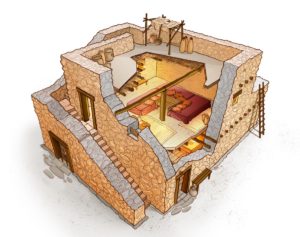The Last Passover in the Upper Room

As the sun went down on Thursday, the fourteenth of Nissan, the nation of Isra’el welcomed a new day. It was Friday the fifteenth of Nisan, a day that would forever change the world. Gentiles consider the Passover to have taken place on Thursday night because in their way of reckoning time. But for the children of Isra’el, the Passover took place on Friday, the fifteenth of Nisan because for Jews, the night precedes the day: And there was evening, and there was morning – the first day (Genesis 1:5b). Consequently, in the Jewish mind, the Passover Seder, the agony of Gethsemane, the religious trial, the civil trial, Messiah’s crucifixion, death and burial all took place before sundown on the same day (to see link click Ix – The Examination of the Lamb).
There are several names for the Passover. The first name is Hag Ha-Pesach which means the Feast of the Passover found in Exodus 34:25.
The second name is Pesach. That is the Hebrew word for Passover. The emphasis is on the Angel of Death motif; upon the fact that during the tenth plague the Angel of Death passed over the Jewish homes but he did not pass over the Egyptian homes. This second name is used in four different ways. First, it is applied to the feast of Passover alone. Secondly, the term Passover is sometimes used to include both the Feast of the Passover and the Feast of Unleavened Bread because the day after the Passover began the seven days of the Feast of Unleavened Bread. Thirdly, it is applied to the sacrificial lamb in reference to the lamb that was sacrificed on the first day of Passover in the Temple compound. Fourthly, it is applied to the Passover meal itself. That which is known among the Jewish people as the Seder, the meal eaten on the first night of Passover, is sometimes called the Passover.
The third name is Hag Heaviv, which means the Feast of Spring because it is the first feast of the Spring cycle. There are seven festivals of Israel as portrayed by Leviticus 23 and these seven festivals are grouped in two cycles. First there is a group of four that come very close together and all take place in the spring. Then there is a long break followed by a group of three that also come very close together in the fall. The Passover is the first of the first cycle of feasts that occur in the spring and so it is sometimes referred to as the Feast of the Spring.
The fourth name is Zman Cheruteinu, which means the Season of Our Emancipation, or the Time of Our Freedom. This name emphasizes the results of the Passover: freedom from slavery.
The original biblical practice involved two major elements: the killing of the lamb (Exodus 12:6), and the Passover meal itself (Exodus 12:8). During the many years of Jewish history, however, the rabbis added many other practices to it, as you shall see in the Passover that took place in the Upper Room with Christ and His talmidim.1365
The rabbis teach that on the evening of the Passover, heralds were sent out by the Great Sanhedrin crying out, “Jesus goes out to be executed because He practiced sorcery because He was possessed by Beelzebub (Mark 3:22), and seduced Isra’el, and alienated her from her God.” And non-messianic Jews believe that to this day. “Let anyone who can bring forward a justifying plea for Him come forward and give information concerning Him.” But the rabbis teach that no justifying plea was found, and so they crucified Jesus on the eve of the Sabbath at the Passover.



Leave A Comment